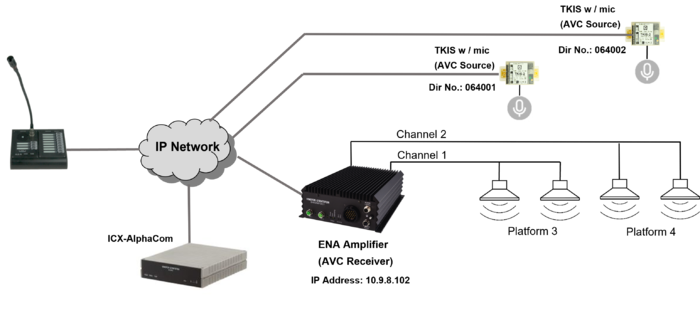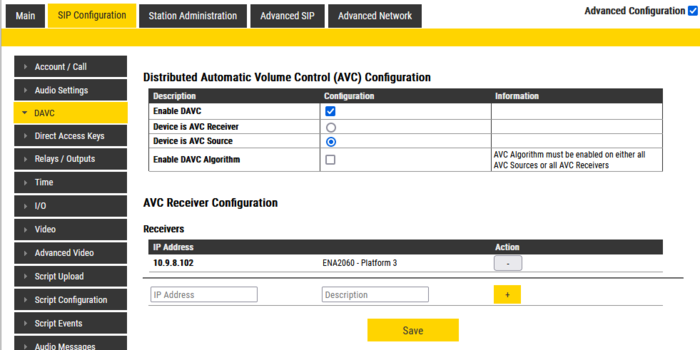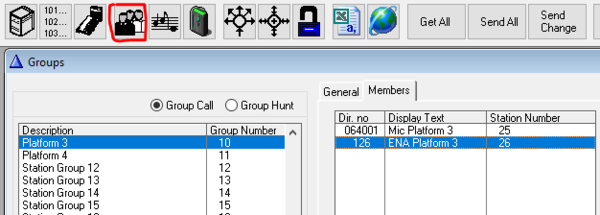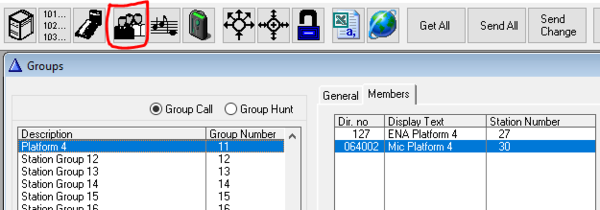Difference between revisions of "Distributed Automatic Volume Control (DAVC)"
From Zenitel Wiki
(→ICX-AlphaCom Configuration) |
(→Related articles) |
||
| (7 intermediate revisions by the same user not shown) | |||
| Line 34: | Line 34: | ||
<br style="clear:both;" /> | <br style="clear:both;" /> | ||
| − | {{note|The checkbox "'''Enable DAVC Algorithm'''" must be unchecked | + | {{note|On the AVC Source: |
| − | + | * The checkbox "'''Enable DAVC Algorithm'''" must be unchecked | |
| + | *The local "'''AVC feature'''" on the AVC source MUST be disabled. See [[Automatic Volume Control (AVC)|AVC feature]] | ||
| + | *Host name is not supported, only IP Address. Due to this, the AVC Receiver should have static IP address | ||
| + | * '''Reboot''' the device for all the DAVC settings to take effect }} | ||
===AVC Receiver === | ===AVC Receiver === | ||
| Line 74: | Line 77: | ||
**The different settings are: '''Highest, Average, Average Mid'''. "Average" requires two or more AVC Sources. "Average Mid" will remove high and low values if more than 4 AVC sources, and average rest. | **The different settings are: '''Highest, Average, Average Mid'''. "Average" requires two or more AVC Sources. "Average Mid" will remove high and low values if more than 4 AVC sources, and average rest. | ||
| − | {{Note|If the AVC receiver is a [[TKIS-2]] or TKIS-2 based device (e.g. [[:Category:Intercoms_and_Devices|IP Loudspeaker]]), make sure the inbuilt [[Automatic Volume Control AVC|AVC is disabled]].}} | + | {{Note|If the AVC receiver is a [[TKIS-2]] or TKIS-2 based device (e.g. [[:Category:Intercoms_and_Devices|IP Loudspeaker]]), make sure the inbuilt [[Automatic Volume Control (AVC)|AVC is disabled]].}} |
| + | |||
| + | {{Note|'''Reboot''' the device for all the DAVC settings to take effect.}} | ||
==== Firewall settings ==== | ==== Firewall settings ==== | ||
| Line 80: | Line 85: | ||
| + | === Monitoring and Tuning the DAVC feature === | ||
| + | The [[Turbine_Test_and_Demo_Application#AVC_Gain_adjustment_data|Test & Demo Tool]] can be used to monitor the performance of the DAVC feature, and as a tool during the commissioning of the DAVC. | ||
| + | <br> | ||
== ICX-AlphaCom Configuration == | == ICX-AlphaCom Configuration == | ||
| Line 96: | Line 104: | ||
[[File:DAVC GRP2.png|thumb|600px|left|The microphone (AVC Source) must be in the same group as the amplifier channel]] | [[File:DAVC GRP2.png|thumb|600px|left|The microphone (AVC Source) must be in the same group as the amplifier channel]] | ||
<br style="clear:both;" /> | <br style="clear:both;" /> | ||
| − | |||
| − | |||
| − | |||
| − | |||
| − | |||
| − | |||
| − | |||
| − | |||
| − | |||
| − | |||
| − | |||
| − | |||
| − | |||
| − | |||
| − | |||
| − | |||
| − | |||
| − | |||
| − | |||
| − | |||
| − | |||
| − | |||
| − | |||
| − | |||
| − | |||
| − | |||
| + | == Related articles == | ||
| + | * [[ENA_Amplifier_Configuration_(SIP)#Play_Media|Play test signals from the ENA amplifier]] for tuning volume/gain adjustments | ||
| + | * DAVC in SIP based systems: [[Distributed Automatic Volume Control (DAVC) (SIP)]] | ||
[[Category: Public Address - Features and configuration]] | [[Category: Public Address - Features and configuration]] | ||
Latest revision as of 13:36, 27 June 2024
The Distributed Automatic Volume Control (DAVC) is an algorithm which is using one or more microphones ("AVC Source") to measure the ambient audio/noise level, and adjusts the loudspeaker output level of the PA amplifier ("AVC Receiver") according to the ambient audio level.
- The AVC Source is the input device with the listening microphone used for measuring the ambient noise level. This is typically an EINS-1 microphone unit, but any Turbine Device with microphone can be used. The AVC Source sends its microphone measurements to the AVC Receiver.
- The AVC Receiver is the output device that is used for playing audio, typically an ENA amplifier, or a PA Interface such as a TKIS-kit or TKIE-kit.
DAVC is not operating while audio is active on the AVC Receiver. With the default configuration, it needs minimum 100ms of silence to be able to adjust the gain by 1dB. This should work just fine with normal speech, but AVC will not adjust while playing constant music.
Contents
Software and license requirements
- The Distributed Automatic Volume Control (DAVC) is supported as from:
- Turbine: v. 4.11
- ICX-AlphaCom: Any firmware
- AlphaCom XE: v. 12.5.3.1
- Licensing ICX-AlphaCom:
- The AVC Source (microphone) requires an AVC License (1002600600 - ILS-AVC)
- The ENA Amplifier requires one, two or three ENA Amplifier licenses (1002600500 - ILS-AMP), depending on how many channels it's using
- Licensing AlphaCom XE:
- The AVC Source (microphone) requires an "AVC License
- The ENA Amplifier requires one, two or three ENA Amplifier licenses, depending on how many channels it's using
Device configuration
AVC Source
The AVC Source is the input device with the listening microphone used for measuring the ambient noise level. This is typically an EINS-1 microphone unit, but any Turbine Device with microphone can be used.
Log in to the web interface of the AVC Source, and enable Advanced Configuration. Select Sip Configuration > DAVC. Check the settings Enable DAVC and Device is AVC Source. Uncheck the other options.
Under AVC Receiver Configuration add the IP address and a descriptive name of the AVC Receiver(s):

|
On the AVC Source:
|
AVC Receiver
The AVC Receiver is the output device that is used for playing audio, typically an ENA amplifier, or a PA Interface such as a TKIS-kit or TKIE-kit.
Log in to the web interface of the AVC Receiver, and enable Advanced Configuration. Select Sip Configuration > DAVC. Check the settings Enable DAVC, Device is AVC Receiver and Enable DAVC Algorithm.
If the AVC Receiver is an ENA Amplifier, the Master Volume [-40 - 2] dB sets the base gain of the two output channels. Set a low base gain when using "Positive Mode", and a high base gain when using "Negative Mode" (see below explanation).
The AVC Algorithm has a set of parameters for tuning the feature:
- Adjustment Mode:
- Positive Mode: Gain adjustment is from zero at AVC threshold level and adjusted positive. AVC Receiver should have a low base gain.
- Negative Mode: Gain adjustment is from zero at AVC max level and adjusted with negative gain downwards. AVC Receiver should have a high base gain.
- Lower Threshold: Threshold level for the AVC to start working. Valid range: 30-80 dBA. Default is 55 dBA.
- Upper Threshold: Threshold level for the AVC to stop working. Valid range: 60-120 dBA. Default is 100 dBA.
- Attack Rate: How quickly the AVC adjusts gain on raising ambient audio level. Range: 1..100 dBA/sec. Default is 10 dBA/sec.
- Decay Rate: How quickly the AVC adjusts gain on falling ambient audio level. Range: 1..100 dBA/sec. Default is 10 dBA/sec.
- Hysteresis: Hysteresis around previous set ambient audio level before doing adjustments. Range: 1..10 dBA/sec. Default is 3 dBA.
- Far-End Lockout Time: When playing audio in AVC zone (far-end-signal) AVC adjustments are locked. When there is a pause in the far-end-signal, adjustment commences after this lockout-time. Range: 1..100. Resolution is 100 ms. Default is "1" (= 100 ms).
Under AVC Source Devices enter information about the remote microphone device(s):
- Source Number: The directory Number of the remote microphone device
- Audio Channels: Which audio channel(s) on this device should be effected by signals from the remote AVC Source
- Source Selection Strategy: The AVC Receiver will receive ambient audio levels or Gain adjust values from a number of AVC Sources. This configures the selection strategy for final gain adjusts on AVC Receiver.
- The different settings are: Highest, Average, Average Mid. "Average" requires two or more AVC Sources. "Average Mid" will remove high and low values if more than 4 AVC sources, and average rest.

|
If the AVC receiver is a TKIS-2 or TKIS-2 based device (e.g. IP Loudspeaker), make sure the inbuilt AVC is disabled. |
Firewall settings
On the AVC Receiver, AudioData (UDP port 5035) must be enabled in the Firewall.
Monitoring and Tuning the DAVC feature
The Test & Demo Tool can be used to monitor the performance of the DAVC feature, and as a tool during the commissioning of the DAVC.
ICX-AlphaCom Configuration
For the DAVC feature to work properly, the AVC Sources must be exposed to the same audio as the AVC Receivers.
Due to this, the AVC Sources (microphones) must be included in the same group calls as the AVC Receivers (ENA amplifiers).
From AlphaPro, in the Groups > Local Groups window, include the ENA Amplifier channel and its related microphone in the same group.
Zone 1:
Zone 2:
Related articles
- Play test signals from the ENA amplifier for tuning volume/gain adjustments
- DAVC in SIP based systems: Distributed Automatic Volume Control (DAVC) (SIP)








